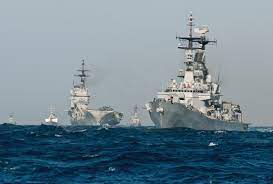Italy: New warships will boast bigger bellies for landing forces

Rome: The Italian Navy is planning new ship purchases to push its on-board accommodation for amphibious landing force staff and troops to 1,700, officials have told Defense News.
Three new 16,500-tonne vessels will replace smaller vessels and combine with Italy’s new Trieste Landing Helicopter Dock to improve Italy’s ability to get combat forces from ship to shore, officials said.
“This will give us the amphibious task force we need to combine with a carrier strike group, submarines and special forces to complete the so called ‘trident’ of expeditionary forces,” said Rear Adm. Marco Tomassetti, who heads the Navy general staff’s surface capability development department.

Italy’s amphibious forces, which are a team-up of the Navy’s San Marco brigade and the Army’s Venice-based Serenissima regiment, currently rely on three 8,500-tonne ships, the San Marco, San Giorgio and San Giusto, which are due for retirement.
Funding worth €1.2 billion($1.3 billion) has been allocated for the first two of three planned replacements, with an in-service date of 2028-30 for the first two, followed by the third in 2031.
Diesel-powered with a top speed of around 20 knots and 7,000 nautical mile autonomy, the new vessels will be around 160 meters long and 29 meters wide with room for 200 crew and a 300-strong landing force.
“They will be called ‘LXD’s with the X standing for ‘whatever’ because we don’t want to limit the role they fill,” said Tomassetti.
They will join the larger, 38,000-tonne Trieste LHD, which enters service next year and is the largest post-WWII vessel built by the Italian navy. All vessels are being built by Italian yard Fincantieri.
The new ships will collectively accommodate around 1,700 transported staff and troops.
“Together, all four vessels will carry two maneuver units drawn from the San Marco and Serenissima to create a national amphibious task group,” said Tomassetti.
Unlike the vessels they replace, which have a flight deck stretching almost the length of the ship, the new LXDs will only have a rear section of the top deck for hosting two helicopters, typically the NH-90 and EH-101.
The design, similar to the Dutch Rotterdam class, means less room on the flight deck for transporting material and vehicles, but more room below deck in the garage and dock for vehicles – up to around 70 tonnes in total – with space for around 480 meters of vehicles lined up, compared to around 200 meters on the old San Giorgio class.
“Keeping all the vehicles below decks means we avoid needing to use the flight deck simultaneously for flying and for carrying material and vehicles,” said Tomassetti.
Below decks, several load configurations are possible, including one which allows the embarkation of around 20 of the new wheeled, amphibious vehicles Italy signed to buy this year from local company Iveco.
Italy first issued a requirement for a new amphibious vehicle over a decade ago, leading to Iveco developing its SUPERAV 8X8, which in the meantime has become the basis for the U.S. Marines’ new Amphibious Combat Vehicles. Iveco retained design authority for the Marine Corps rides while BAE Systems took on the role of prime contractor.
The new Italian vessels will also accommodate in their floodable deck two LC-23 landing craft, built by Italy’s Vittoria, which can carry around 70 tons and 20 meters of vehicles lined up in each.
The new craft were initially designed for the Trieste, which will carry four.
The LXDs will host the same Kronos Power Shield L-Band radar installed on the Trieste, as well as a 30mm close-in defense gun. Tomassetti said the final price of the ships was yet to be set, commenting: “Recent international events caused an overall increase of prices, especially for raw material, thus making any forecast price prevision valid just for a very short time.”





